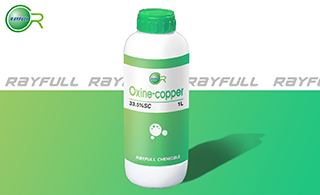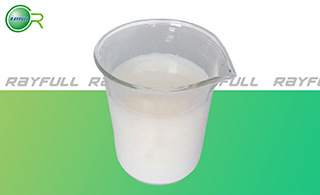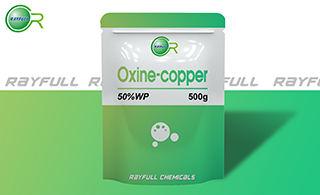Oxine-copper
    喹啉铜 喹啉铜
Introduction: Oxine-copper is used in formulating antiseptics, deodorants, antiperspirants and fungicides. The biological property of copper compounds takes important role in as fungicides in agriculture and biocides in antifouling paints for ships and wood preservations. Very low level of copper is toxic to fungi and algae but the levels for mammal is much higher. The copper ions inhibit the metabolism of the fungus when they react with sulfur containing enzymes in the plant. Copper compounds form a protective barrier on the plant surface and thereby prevent fungi from entering the plant host. The fungicidal effect of copper compounds as non-systemic fungicides are such as bordeaux mixture, cupric hydroxide, copper arsenate, copper carbonate, cuprous oxide, copper-8-quinolinolate, copper oleate, copper sulfate, or copper oxychloride. Another important biocide application of copper compounds, such as copper sulfide is as an antifouling agent in paints.
Common name: Oxine-copper
Another name: Copper quinolin-8-olate; Copper oxine; Cunilate; Cuproquin; etc.
Chemical name: 2-(thiazol-4-yl)benzimidazole
Empirical formula: C18H12CuN2O2
Structural formula:

Mol. Weight: 351.89 g/mol
CAS No.: 10380-28-6
Specifications
Leading Oxine-copper supplier
Oxine-copper 98% TC
Oxine-copper 50% WP
Oxine-copper 33.5% SC
Packing:
BULK PACKING
Powder: 25kg/Bag, 25kg/Drum, 50kg/Drum etc.
Liquid: 200L/Drum, 20L/Drum, 10L/Drum etc.
SMALL PACKING
Powder: 1kg/Alu bag, 500g/Alu bag, 200g/Alu bag, 100g/Alu bag, 50g/Alu bag, 15g/Alu bag etc.
Liquid: 5L/Drum, 1L/Bottle, 500ml/Bottle, 250ml/Bottle, 100ml/Bottle, 50ml/Bottle etc.
Customerized packing label
Oxine-copper FAO standard
Professional registration
HAZARDS IDENTIFICATION
Hazard statement(s)
H315 (95.24%): Causes skin irritation.
H319 (98.41%): Causes serious eye irritation.
H330 (79.37%): Fatal if inhaled.
H335 (17.46%): May cause respiratory irritation.
H400 (80.95%): Very toxic to aquatic life.
Precautionary statement(s)
P260: Do not breathe dust/fume/gas/mist/vapors/spray.
P264: Wash ... thoroughly after handling.
P273: Avoid release to the environment.
P284: [In case of inadequate ventilation] Wear respiratory protection.
P302+P352: IF ON SKIN: wash with plenty of water.
P304+P340: IF INHALED: Remove person to fresh air and keep comfortable for breathing.
P305+P351+P338: IF IN EYES: Rinse cautiously with water for several minutes. Remove contact lenses if present and easy to do - continue rinsing.
P310: Immediately call a POISON CENTER or doctor/physician.
P321: Specific treatment (see ... on this label).
P332+P313: IF SKIN irritation occurs: Get medical advice/attention.
P362: Take off contaminated clothing.
P391: Collect spillage.
P403+P233: Store in a well-ventilated place. Keep container tightly closed.
P405: Store locked up.
P501: Dispose of contents/container to an approved waste disposal plant.
Supplemental Hazard Statements: none.
MAMMALIAN TOXICOLOGY
Acute toxicity: 1) Acute oral LD50 for male rats is 585 mg/kg, for female rats is 500 m/kg. 2) Acute dermal LD50 for rats is >2000 mg/kg. 3) Acute inhalation toxicity LC50 (4 h) for rats is 0.15 mg/L. 4) Skin irritation: Non-irritating to skin (rabbits). 5) Eye irritation: Irritating to eyes (rabbits). 6) Skin sensitization for guinea pig: Not a skin sensitizer.
NOEL: (2 y) for rats is 1.11 mg/kg/day. Other Not genotoxic.
ADI 0-0.02 mg/kg b.w.
Classification:
WHO Classification: Not available
EC Risk Classification: Not available
US EPA Classification (formulation): Not available
ECOTOXICOLOGY
Effect on birds: Acute oral LD50 for Bobwhite quail is >2619 mg/kg. Effect on fish: Acute LC50 (96 h) for Bluegill sunfish is >0.24 mg/l. Effects on aquatic invertebrates: Acute EC50 (48 h) for Daphnia magna is >0.132 mg/l. Effects on algae: Acute 72 hour EC50 for Pseudokirchneriella subcapitata is 0.046 mg/l.
ENVIRONMENTAL FATE
Animals In rats, 58-62% is excreted in urine and about 25% eliminated in faeces within 72 h. Metabolites were mainly parent and 8-hydroxyquinoline and a small amount of glucuronide and sulfate conjugates. Plants The product does not penetrate and is not translocated after foliar application after one week in lettuce and up to four weeks in apple. No metabolites were observed in the surface wash-off. Soil/Environment DT50 2 d (20℃, 63% MWC). No tendency to leach (90% remained in the 0-6 cm top soil layer).
Usage: Oxine-copper was developed by Syngenta. It is an obsolete copper fungicide used primarily as a wood preservative.
Application: Mode of action Non-systemic, protective fungicide. Uses Seed treatment for control of glume blotch, bunt, and snow mould of wheat; Cercospora, Phoma, and Pythium spp. in beet; Alternaria and Botrytis spp. in flax; Alternaria and Phoma spp. in oilseed rape; Sclerotinia sclerotiorum in sunflowers; and leaf spot on beans and peas; application rates range from 20-100 g/100 kg seed; also for control of leaf spot on celery; and scab and canker on pome fruit. Also used for sealing wounds and pruning cuts on trees, and for treatment of fruit- and potato-handling equipment. Phytotoxicity Non-phytotoxic when used as directed. Not to be used on copper-sensitive plants.
| 






